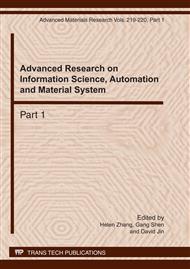[1]
J.Mitola, Q.Gerald, J.R. Maguire: Cognitive Radios: Making Software Radios more personal . IEEE Personal Communications, vol.6: 13-18(1999).
DOI: 10.1109/98.788210
Google Scholar
[2]
I.Akyildiz, W.Y. Lee, M.C. Vuran,etal:Next generation dynamic spectrum access cognitive radio wireless networks: A survey .Computer Networks, 50(13):2127-2159(2006).
DOI: 10.1016/j.comnet.2006.05.001
Google Scholar
[3]
HE Xin-ying,Zeng Zhi-min,Guo Cai-li: A Dynamic Spectrum Access Algorithm Based on Probability Density Estimation in Cognitive Radio. Journal of Beijing University of Posts and Telecommunications, 32(1):108-112( 2009).
Google Scholar
[4]
Jungmin So,Nitin H. Vaidya: A Routing Protocol for Utilizing Multiple Channels in Multi-Hop Wireless Networks with a Single Transceiver. Urbana: University of Illinois at Urbana- Champaign (2004).
Google Scholar
[5]
Charles E. Perkins, Elizabeth M. Royer. Ad-hoc On-Demand Distance Vector Routing. the Second IEEE Workshop on Mobile Computing Systems and Applications (WMCSA99), 90-100(1999).
DOI: 10.1109/mcsa.1999.749281
Google Scholar
[6]
C. Xin, B. Xie, C.-C. Shen:A novel layered graph model for topology formation and routing in dynamic spectrum access networks. IEEE Symposium on New Frontiers in Dynamic Spectrum Access Networks, 308–317(2005).
DOI: 10.1109/dyspan.2005.1542647
Google Scholar
[7]
Krishnamurthy, M. Thoppian, S. Venkatesan, and R. Prakash: Control based MAC-layer configuration, routing and situation awareness for cognitive radio networks, IEEE MILCOM05, vol.1:455-460(2005).
DOI: 10.1109/milcom.2005.1605725
Google Scholar
[8]
T.Fujii, Y. Kamiya, Y. Suzuki. Multi-band ad-hoc cognitive radio forreducing inter system interference.IEEE PIMRC'06, 1-5(2006).
DOI: 10.1109/pimrc.2006.254062
Google Scholar
[9]
H.Khalife, S.Ahuja, N.Malouch,etal: Probabilistic Path Selection in Opportunistic Cognitive Radio Networks . IEEE GLOBECOM'08, 4861-4865(2008).
DOI: 10.1109/glocom.2008.ecp.931
Google Scholar


